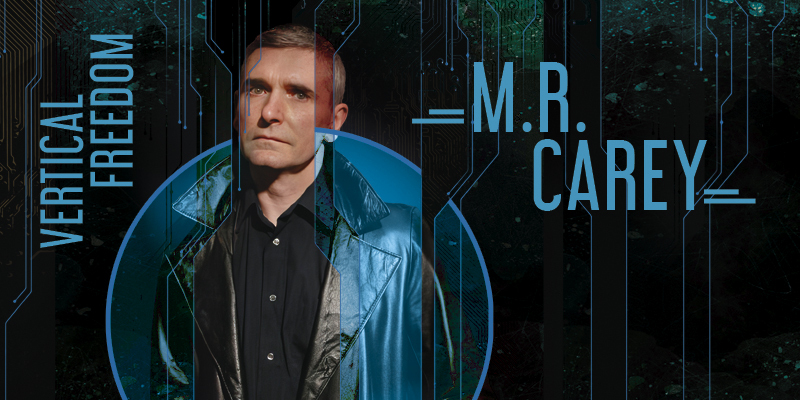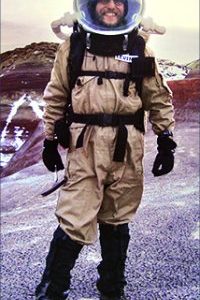M.R. Carey: Vertical Freedom
MICHAEL R. CAREY was born in Liverpool, England in 1959. He attended St. Peter’s College, Oxford, where he studied English, and worked as a teacher for 15 years before becoming a professional writer.
His career began as a comics writer in the 1990s, first for smaller companies and later for Marvel and DC. He is best known for the Lucifer series (1999-2006) and his run on Hellblazer (2002-2006). The Unwritten, Vol. 2: Inside Man (2011) and The Unwritten, Vol. 2: Leviathan (2012), with art by Peter Gross, were finalists for the Hugo Award for best graphic story, and Darkness Visible (2018), cowritten with Arvind Ethan David, was a Bram Stoker Award finalist in the graphic novel category.
Carey’s debut novel was The Devil You Know (2006), first in the Felix Castor urban fantasy series, which continued with Vicious Circle (2006), Dead Men’s Boots (2007), Thicker than Water (2009), The Naming of the Beasts (2009), and The Ghost in Bone (2023).
He wrote The Dead Sea Deception (2011) and The Demon Code (2012) in the Heather Kenney series under the name Adam Blake. With his wife, Linda Carey, and daughter, Louise Carey, he cowrote The Steel Seraglio (2012), inspired by the Arabian Nights, and gothic novel The House of War and Witness (2014).
As M.R. Carey, he wrote postapocalyptic SF novel The Girl with All the Gifts (2014), an Arthur C. Clarke Award finalist, and sequel The Boy on the Bridge (2017); both were British Fantasy Award finalists. The first book was adapted as a film in 2016, with a script by Carey.
Later books have also appeared under the M.R. Carey byline, including the postapocalyptic Rampart sequence, beginning with The Book of Koli (2020), recipient of a special citation in the Philip K. Dick Awards, and continuing with The Trials of Koli (2020) and The Fall of Koli (2021). He also wrote standalones Fellside (2016) and Someone Like Me (2018)
His latest work is the sprawling multiverse novel Infinity Gate (2023), a Dick Award finalist, and sequel Echo of Worlds (2024), the Pandominion duology.
His story “Taproot” (2019) was a Shirley Jackson Award finalist. Some of his short fiction has been collected in The Complete Short Stories of Mike Carey (2019).
Excerpt from the interview:
“One of the fascinating things about apocalypses is they remove the usual frameworks. In ordinary life, a lot of what we do is controlled and mediated by our social roles – we’re given scripts and we work to the scripts, and there are these frameworks around us all the time. The apocalypse removes those, so it’s like: What does human nature become?
“Boy on the Bridge is a prequel-equal-sequel: It starts before the events of The Girl with All the Gifts, and then it has a little postscript which is after the events of Girl. You never meet Melanie, and though you do hear of some of the characters from the previous book, it’s a free-standing story.
“I always lose the battle on titles. The only time Orbit had ever accepted a title from me it was The Girl with All the Gifts. The prequel was meant to be The Boy on Bedlam Bridge because I had this character, Stephen Greaves, who is maybe just suffering PTSD, or maybe is actually mentally ill, who behaves weirdly in some people’s eyes because he’s also on the autistic spectrum and has some traits are probably due to that. Nobody’s entirely certain how to take him, so I had a title that sort of played with that ambiguity.
“Coming back to Girl with All the Gifts, there’s one other thing that’s worth mentioning there, which is I think it’s a massive departure from everything that I’d written in prose before. There’s a reason for that, which is, for the two years before I wrote Girl with All the Gifts, in 2012-2014, I was collaborating with my wife Linda and my daughter Louise on two novels, City of Silk and Steel and House of War and Witness. They’re both quite playful stories, loosely inspired by The Thousand and One Nights, so you have the suite of stories within stories, shifts in point of view, shifts in narrative style, and shifts in genre. We had to find a voice to write for all three of those, and Linda and Louise had both already published and had voices of their own. I came out of that experience sensitized to things that I’d done without thinking about them much, up to that point. Also, I came out more willing to experiment with style and voice than I had been before. In The Girl with All the Gifts, the main character is a very young girl, who has lived a really sheltered life, with very little knowledge of the world, and I wanted to find a style that would convey the immediacy of a child’s perceptions – the way that when you’re a kid, anything can fill your whole world from horizon to horizon, because it just hits you full on. I used narrative present, which I hadn’t done before, and I also wrote in very short, declarative sentences, a very stripped-down and simple style – at least, that’s what I was aiming for. I didn’t always hit it.
“I think there were an awful lot of people who didn’t realize all these things were written by the same person. The Girl with All the Gifts came out under the transparent pseudonym ‘M.R. Carey’ instead of Mike Carey. The thinking behind that was, when my editors read the novel, they thought it had the potential to appeal to an audience that was somewhat wider than the audience of zombie fiction readers, generally. They thought my book had – I hate to use this phrase – crossover appeal, and might pull in a nongenre audience, and they decided the best way to achieve that was to not say anything in the blurb about zombies, and also to hide the fact that it was me, by giving me a slightly different name. They asked me what my middle initial was – it’s J – so the book was going to be credited to M.J. Carey. But then they realized there was already an M.J. Carey on Goodreads, and she writes bondage porn – a lot of bondage porn. Unfortunately, the title The Girl with All the Gifts takes on different connotations alongside some of her other works. So they changed my initials to M.R.
“The Book of Koli was another case of moving from a short story to a novel. The story was called ‘All That’s Red Earth’, and I wrote it for an anthology that was going to be called Winter Wonderlands for PS Publishing. The book never came out, but I submitted the story. The voice came first, with Koli. Initially, it wasn’t a postapocalyptic world, it was a pseudomedieval world. I wanted a story told in first person by a character who was barely literate, who has never really appreciated books, has come to reading and writing late, and is trying to tell his story in an idiosyncratic way. The immediate inspiration – which is going to sound weird – was Huckleberry Finn. I wanted Koli to sound a little bit like Huck, and have some of that sort of power and music that we get from Huck. I wrote the short story, and when I decided to try turning it into a novel, I started playing with perspective. In the original story, it’s not Koli, it’s the character that became Cup, whose name was Tari in the short story. The big reveal was that the character is a trans woman, and all of the structure of the story builds up to that reveal I didn’t think I could carry that structure across into a novel, much less into a trilogy. I had to rethink it and strip it down and move stuff around, and I ended up with a sci-fi story instead of a fantasy story. All I saved from the story, really, was the voice, and a sense of the story being about somebody who ends up at odds with their community, and has to abandon most of their understanding of the world, and then learn a different world and a different set of rules for engagement. Which, I guess, Melanie does, too, in The Girl with All the Gifts. So there’s that point of comparison.
“Like a lot of my stuff, The Book of Koli is a story about stories, and the persistence of stories – the ways in which we make sense of ourselves through stories, both as individuals and as a community and a society. In The Shadow of the Torturer and its sequels by Gene Wolfe, I absolutely love how he will tell you, with a straight face, a story that turns out to be the tale of Theseus and the Minotaur – a story that we know from our own mythologies, but distorted by all of the social shifts that have happened through our time and Severian’s time. I wanted to play with some of those things in Koli as well.
“There’s also a lot of picaresque stuff. When I’m writing I need to know what the ending is – what I’m aiming for. In the case of The Book of Koli, the way the story ends, and what happens to the village in his absence, and the fact that he comes back in time to intervene in the war, all that stuff was locked in. But there was a lot of episodic stuff, especially in the first two books, that was much more loosely planned. He goes out, he finds the world, he meets Senlas, he goes to Many Fishes village, and there’s all that stuff with the sea-bear, which I made up as I went along and had fun with. The book shows a gradual broadening of Koli’s perspective, as he learns not just the world as it is now, but also how it became that way, and finds the bones of the past on which his world is built, whether anyone knows it or not.
Interview design by Francesca Myman
Read the full interview in the June 2024 issue of Locus.
 While you are here, please take a moment to support Locus with a one-time or recurring donation. We rely on reader donations to keep the magazine and site going, and would like to keep the site paywall free, but WE NEED YOUR FINANCIAL SUPPORT to continue quality coverage of the science fiction and fantasy field.
While you are here, please take a moment to support Locus with a one-time or recurring donation. We rely on reader donations to keep the magazine and site going, and would like to keep the site paywall free, but WE NEED YOUR FINANCIAL SUPPORT to continue quality coverage of the science fiction and fantasy field.
©Locus Magazine. Copyrighted material may not be republished without permission of LSFF.








